Contents
Excessive sweating of the hands
Hyperhidrosis is defined as excessive sweating than normal, which does not occur as a result of an increase in temperature or as a result of exercise. This is evident on the clothes as if they are wet, especially under the armpits or on the hands or feet, which makes a person embarrassed with the surrounding community. He may not be able to hold a pen, shake hands with others, or drive a car; This may disrupt normal daily activities. Armpit problems usually start in late teensWhile the problem of sweating hands and feet often begins at an early age, on average, at the age of 13. It is worth noting that if the problem is not treated, it may continue throughout life, and treatment is using antiperspirants, and if these drugs do not work, other drugs may be resorted to, and in severe cases the doctor may suggest surgery to either remove the glands Ethnicity or to separate the nerves responsible for excessive sweating. In some cases, the underlying cause of hyperhidrosis may be found and treated. [1] [2]
Causes of excessive sweating of the hands
In fact, sweating in the normal position works to keep the body cool, and people sweat more in the normal position when the weather is hot or when practicing sports activities, or when they are exposed to situations that cause anger, embarrassment, or fear. As for the case of hyperhidrosis, whether it is in the hands or other areas of the body, sweating also occurs without exposure to these stimuli, and it is the result of the presence of overactive sweat glands, which makes it difficult for the person to control his sweating, and it causes him discomfort. Hyperhidrosis is divided into two types: [3] [4]
- Primary hyperhidrosis: Primary hyperhidrosis is triggered when the cause of excessive sweating is unknown and runs in families and often occurs in the hands, feet, head and face, and under the armpits.
- Secondary hyperhidrosis: Secondary hyperhidrosis is known as sweating that occurs as a result of other health conditions or as a side effect of a specific drug, and it is characterized by the fact that it affects the whole body or a specific area of it, and it can happen during sleep as well. Among the most important secondary causes of hyperhidrosis, we mention the following: [3]
- Bone of the limbs .
- Anxiety.
- Cancer .
- Carcinoid syndrome.
- Some medicines are used incorrectly.
- Glucose disorder.
- Heart diseases such as; Heart attack .
- Hyperthyroidism.
- Lung disease .
- Reach menopause .
- Disease , Parkinson 's .
- Pheochromocytoma .
- Spinal cord injury.
- brain attack.
- Infectious diseases: tuberculosis or HIV.
- brain attack.
- Adrenal gland disorders.
- Medication side effects excessive sweating, including: anti - depression such as desipramine , and nortriptyline , and Brocrabtelin , and pilocarpine , and zinc .
Treating hyperhidrosis of the hands
The treatment of hyperhidrosis depends on knowing the type of hyperhidrosis and where it occurs in the body, and the dermatologist looks at general health and other factors to determine the appropriate treatment. Among the most important treatments that are used to control hyperhidrosis are the following: [5] [6] [7 ]
- Antiperspirants: where is the antiperspirants first treatment line recommended by doctors, and notes that some patients require regular treatment with anti - sweating, and is its mechanism that it remains on the surface of the skin, and when the body starts secreting sweat enter the sweat glands and fill Vnglgaha, and when it sends a signal For the body to stop producing a lot of sweating, as for its side effects, including: the feeling of burning and inflammation in the skin.
- Ionotophoresis: It is a medical device that sends a low-voltage current through the water, and it works to temporarily stop the work of the sweat glands exposed to the current, and it is usually used on the hands and feet, as most people need about 6-10 sessions to close the sweat glands. To start, the patient may need two or three sessions per week, and the treatment session usually lasts 20-40 minutes. And when results are seen, treatment can be repeated as needed to maintain results. Where the number of sessions can range from once a week to once a month, and side effects of this type of treatment: dry skin, inflammation of the skin, in addition to the possibility of pain or discomfort during the treatment session.
- Botulinum toxin injections: where botox is used and injected into the armpits, and the patient needs to inject very small amounts in many places of the armpits, and as a result of the injection, the patient may suffer from slight pain and discomfort, and the principle of these injections is based on Temporary blocking of chemicals that stimulate the sweat glands in the body, results are noticed 4-5 days after treatment, and the effect lasts from 4-6 months, and sometimes longer.
- Prescription medications from a doctor: Some sufferers receive a prescription for a drug that temporarily prevents them from sweating, and it can also be used for postmenopausal women who sweat excessively from the head only, and these drugs have the advantage of working all over the body; Its mechanism of action is to prevent the sweat glands from working. Side effects include: dry mouth and eyes, blurred vision, and irregular heartbeat.
- Surgeries: In fact, the doctor uses surgeries when other treatments fail to relieve excessive sweating, and among the most important types of surgeries to stop excessive sweating are the following:
- Surgically remove sweat glands. Where the doctor removes the sweat glands from the underarms, and this is usually done in the dermatologist's office so that the anesthesia is only local and the patient remains awake.
- Sympathectomy: This operation is considered one of the major surgeries; Where the specialized surgeon performs it in the operating room, and the principle of its work is based on the surgeon's introduction of a small endoscope directly from the bottom of the armpit, to find out the locations of the nerves responsible for transmitting the nerve signals that the body sends to the sweat glands, and after these nerves are identified, cut and destroyed, and this process is used For the treatment of sweaty palms. Possible side effects include: damage to the nerves between the brain and eyes, low blood pressure, irregular heartbeat, and an inability to tolerate heat.
Complications of excessive sweating of the hands
In fact, some health complications may occur if hyperhidrosis is not treated, and among the main complications of hyperhidrosis are the following: [8]
- Straightened nails .
- The appearance of warts .
- Bacterial infections; Especially around hair follicles.
- Heat rash , which appears as a red rash, is accompanied by itching and causes a tingling sensation, and the rash increases when the sweat ducts are closed and sweat remains trapped under the skin.
- Psychological impact; Excessive sweating can affect a person's self-confidence, and they are exposed to stress and social withdrawal.
References
- ↑ Jennifer Robinson (20/7/2018), "Excessive Sweating (Hyperhidrosis)" , www.webmd.com , Retrieved 25/3/2019. Edited.
- ↑ "Hyperhidrosis" , www.mayoclinic.org , Retrieved 25/3/2019.
- ^ A b Kevin Berman. (14/4/2017), "Hyperhidrosis" , medlineplus.gov , Retrieved 25/3/2019. Edited.
- ↑ Amanda Delgado (13/9/2017), “Hyperhidrosis Disorder (Excessive Sweating) , ” www.healthline.com , Retrieved 8/4/2019. Edited.
- ↑ Bechara F, Gambichler T, Bader A, "Hyperhidrosis" , www.aad.org , Retrieved 9/4/2019. Edited.
- ↑ Robert A Schwartz (2/7/2018), "Hyperhidrosis Treatment & Management" , emedicine.medscape.com , Retrieved 9/4/2019. Edited.
- ↑ "Excessive sweating (hyperhidrosis)" , www.nhs.uk , 11/23/2017, Retrieved 9/4/2019. Edited.
- ↑ Christian Nordqvist (21/12/2017), "What is hyperhidrosis" , www.medicalnewstoday.com , Retrieved 8/4/2019. Edited.






